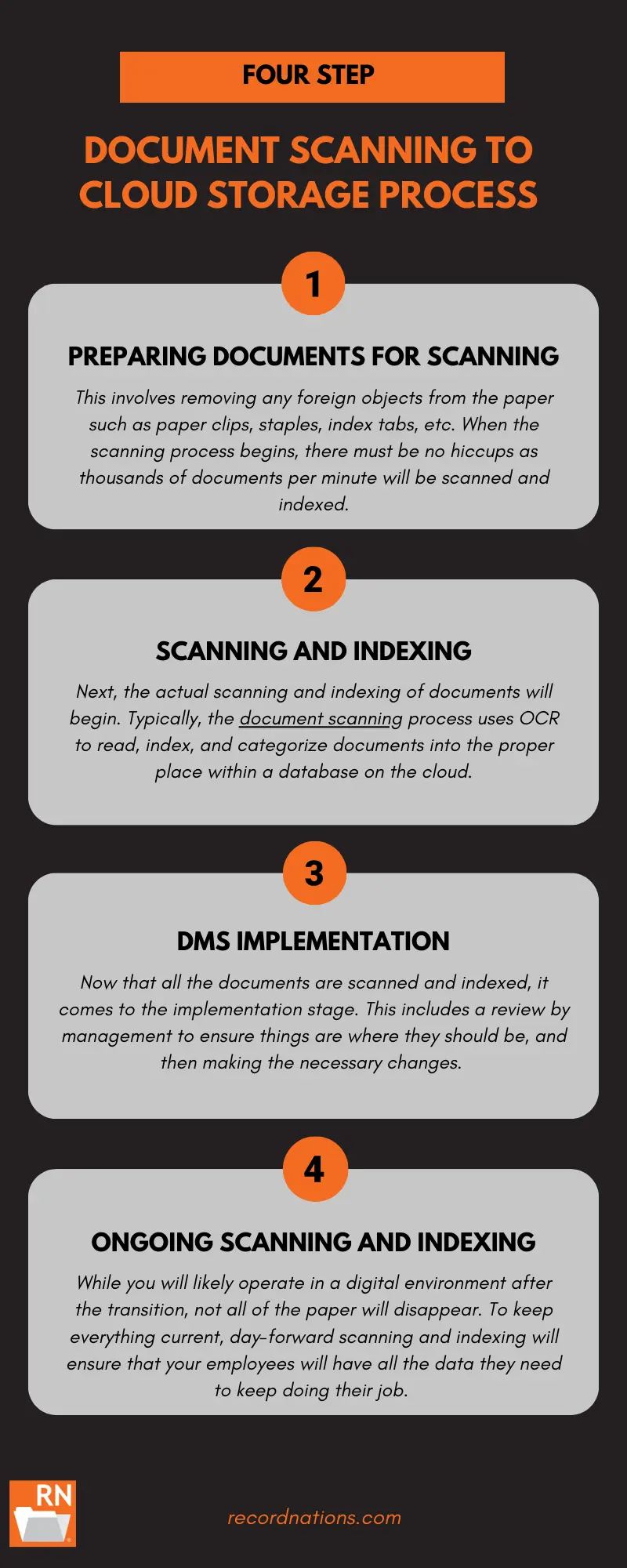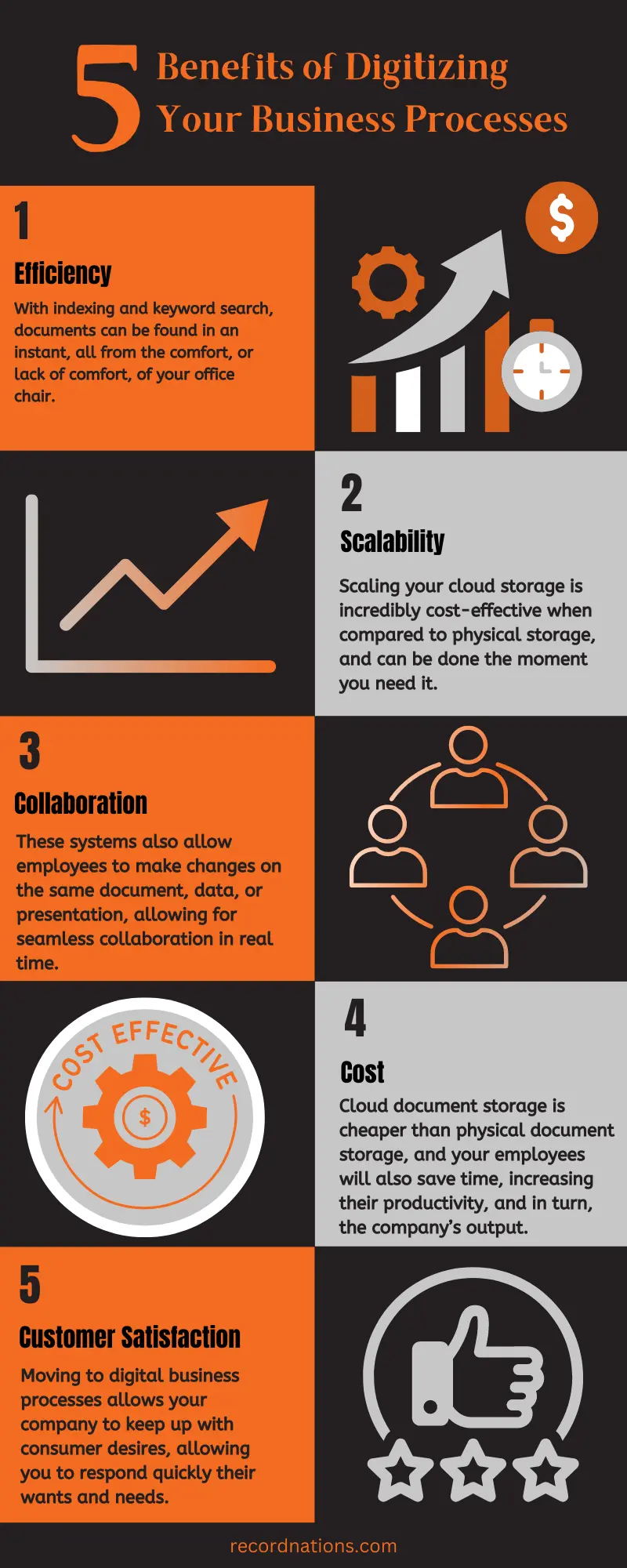
Over the past two decades, companies of all sizes and industries have worked, sometimes painfully, to digitize their business processes. As technology continues to improve, and with the increasing speed of business and consumer demands, it’s more important than ever for companies to consider operating in a digital or hybrid business environment. While this might seem like a time-consuming and difficult process, a document scanning and cloud storage program can make the transition seamless.
This transition is not instant, but nowadays the process is measured in days and weeks. It will take some time for employees to adapt to new processes, but with proper training and buy-in, employee satisfaction and efficiency will increase.
At the end of the day, very few people actually like sorting through file cabinets to find the one document they need to do their job.
How the Document Scanning and Cloud Storage Process Works
If you’ve worked in an office for long enough, you’ve probably scanned plenty of documents to your computer. On a step-by-step basis, there isn’t a huge difference between a document scanning and cloud storage service and your own personal scans. However, there is a difference in the scale, and in the technical capabilities of the machines and the document management system.
Step 1: Prepare Your Documents for Scanning
This involves removing any foreign objects from the paper such as paper clips, staples, index tabs, etc. When the scanning process begins, there must be no hiccups as thousands of documents per minute will be scanned and indexed.
While you don’t have to index the documents yourself, it is a helpful step to make sure everything is organized in the cloud document management system correctly. Otherwise, you’re at the mercy of an AI index, which, while effective, might not place every document where you would like.
Step 2: Scanning to the Cloud and Indexing Your Documents
Next, the actual scanning and indexing of documents will begin. Typically, the document scanning process uses OCR to read, index, and categorize documents into the proper place within a database on the cloud.
Indexing is the most crucial in the process when moving to the cloud. It will organize and set up the documents for future reference by your employees. They will be able to search for documents with a simple keyword search depending on how you choose to categorize them.
Step 3: Implementing the Cloud Document Management System
Now that all the documents are scanned and indexed, it comes to the implementation stage. This includes a review by management to ensure things are where they should be, and then making the necessary changes.
Also included in this step will be some training, as your employees will need to be taught the ins and outs of the new system. The length of this stage will vary, largely depending on the technical know-how of your employees.
However, modern cloud document management systems are much more intuitive than their older counterparts, and it shouldn’t take much time until your company is reaping the benefits from the switch.
Step 4: Day-Forward Scanning and Indexing
While you will likely operate in a digital environment after the transition, not all of the paper will disappear. To keep everything current, day-forward scanning and indexing will ensure that your employees will have all the data they need to keep doing their job.
The Benefits of Scanning and Cloud Storage
Now onto the why. With an initial up-front cost of the scanning and indexing, coupled with the standard subscription fee for cloud services, it’s important to get your money’s worth. Thankfully, a document scanning and cloud storage system provides several important and valuable benefits.
Efficiency
Finding a paper document in an office or storage space, even in well-organized spaces, can at times be similar to trying to find a needle in a haystack. With indexing and keyword search, documents can be found in an instant, all from the comfort, or lack of comfort, of your office chair.
Scalability
Paper has an interesting ability to consume space faster than you expect. While commercial real estate isn’t at a premium at the moment, it’s still not cheap. On the other hand, scaling your storage in the cloud can be done cheaply and quickly, no need for a broker fee.
Collaboration
With a cloud document management system, employees can make changes to documents from anywhere, at any time. These systems also allow employees to make changes on the same document, data, or presentation, allowing for seamless collaboration in real time.
Cost
While there is an initial up-front cost for the switch, a document scanning and cloud storage service will pay for itself over time. Cloud document storage is cheaper than physical document storage, and your employees will also save time, increasing their productivity, and in turn, the company’s output.
Customer Satisfaction
Gone are the days where customers were patient with services and products they desire, if that ever truly existed in the first place. Moving to digital business processes allows your company to keep up with consumer desires, allowing you to respond quickly to their wants and needs, improving their satisfaction and retention.
Find Your Document Scanning and Cloud Storage Solution with Record Nations
Record Nations partners with document scanning and cloud storage providers nationwide to find the best document management solution for every company we work with. To begin your digital transition today, give us a call at (866) 385-3706, or fill out the form on the page, and we’ll connect you to a partner that fits your needs in just minutes.














